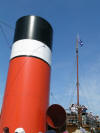Round The World and other travels
A frequent flyer's collection of trip diaries
May 2009 : Argyll Coast
 Many people in Scotland have a tendency to refer
to the City of Glasgow and its immediate surroundings as "the west coast".
It's something that I've never been entirely comfortable with,
despite the proud maritime history of Scotland's largest city.
For one thing, the Clyde continues as a river for another 20 miles
or so north-west of the city, before becoming an estuary. But even then,
the Firth of Clyde is sheltered from the Atlantic Ocean by a
massive natural barrier : the county of Argyll. In the north-west
corner of the county, marking the start of the West Highlands, lies the little town of Oban, the so-called
Gateway to the Isles. And it is, without a shadow of a doubt, on the west
coast.
Many people in Scotland have a tendency to refer
to the City of Glasgow and its immediate surroundings as "the west coast".
It's something that I've never been entirely comfortable with,
despite the proud maritime history of Scotland's largest city.
For one thing, the Clyde continues as a river for another 20 miles
or so north-west of the city, before becoming an estuary. But even then,
the Firth of Clyde is sheltered from the Atlantic Ocean by a
massive natural barrier : the county of Argyll. In the north-west
corner of the county, marking the start of the West Highlands, lies the little town of Oban, the so-called
Gateway to the Isles. And it is, without a shadow of a doubt, on the west
coast.
I made a day-trip to the area on the last day of May 2009, timing that coincided with an unusual spell of genuinely warm, sunny weather and also with the annual sojourn to these parts of PS Waverley, the last seagoing paddle steamer in the world.
Oban
Waverley cruise
PS Waverley
Named after the Scott novel, Waverley was built in 1946 to help continue the long-established tradition of pleasure cruises on the Firth of Clyde. She survived in this role until 1973, when she was sold to the Paddle Steamer Preservation Society for a token sum of £1.
Far from becoming a museum piece, she has been extensively overhauled and now operates a successful programme of cruises in her old stomping ground of the Firth of Clyde, as well as the Thames Estuary, along the South Coast of England, in the Bristol Channel and among Scotland's Western Isles.
She enjoys the distinction of being the world's last surviving seagoing paddle steamer.

















